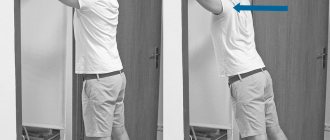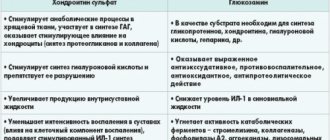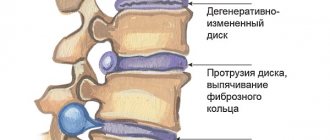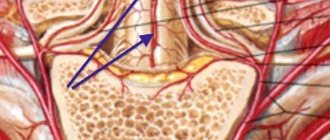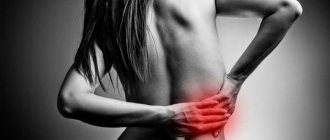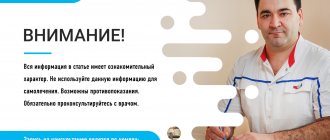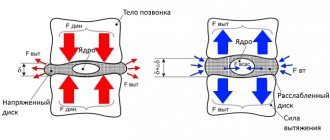Almost every patient who is admitted to the physiotherapy department for neurological complications of osteochondrosis, such as protrusion and hernia of the spine, is prescribed various options for electrotherapy. One of the most common and effective methods of using direct electric current is electrophoresis. Is it possible to do electrophoresis for herniated intervertebral discs? How does this treatment work? What are the possible contraindications, and with what drugs can this therapeutic effect be carried out?
Cervical hernia on MRI.
Description of the procedure
When Karipain is applied to the body, direct current acts as a directed conductor to the source of pain. As a result of varying the current strength, session duration, number of electrodes, and medication concentration, the severity of the therapeutic effect varies.
Karipazim consists of salts, magnesium, calcium, amino acids, sodium and potassium. It destroys protein in cartilage and bone tissue without affecting collagen, thereby reducing the size of the tumor. The medication acts only on the diseased area, without affecting healthy areas of nerve endings and bones.
How does the device for electrophoresis work?
The standard technique for performing the electrophoresis procedure for protrusions or hernias is as follows. Stationary Amplipulse-5 (about 39 thousand rubles), or portable Potok (11 thousand rubles) devices, or more modern devices are used.
Any device is an alternating current rectifier, previously electron tube, currently semiconductor, with regulation of the current strength on the electrodes. Almost all devices operate from a standard alternating current network with a frequency of 50 Hz and a voltage of 220 V, are manufactured according to the second class of protection and, accordingly, do not require grounding devices. The device must be equipped with a milliammeter (either analog with an arrow, or digital in modern devices). There is a potentiometer, or rheostat, that allows you to slowly and smoothly regulate the current in the patient circuit between the electrodes. In older models, there is a separate shunt to the ammeter, which allows you to switch the limits of the measured current from 5 and 50 milliamps.
Apparatus.
In new models, the shunt is integrated into the microcircuit. The device is equipped with output terminals with mandatory polarity markings: “plus” - red and “minus” - white. The kit includes marked wires and a variety of electrodes that can be used as an anode, and in another circuit, as a cathode, since both electrodes are made of the same material. Electrodes are usually made of thin lead because they can bend and follow the curves of the body. Electrodes must be regularly cleaned of lead oxide as oxidized electrodes become less effective. Modern electrodes are made of special fabric impregnated with graphite. They are non-toxic, elastic, and conduct electricity well.
Indications
Most often, the procedure is prescribed by traumatologists, neurosurgeons and orthopedists for diseases of the back and spine. The reason to sign up for electrophoresis with Karipazim is:
- bedsores and necrosis stage I,
- inflammation of the nerve roots of the spinal column,
- inflammation of the hard membranes of the brain,
- burns, abrasions, severe wounds,
- joint fractures,
- pinching of the facial and other nerves,
- excessive brain tone.
Intervertebral disc herniation: Prevention and Recovery
- Strengthen the muscular corset of the spine. Strengthening your muscles will help stabilize and support your spinal column. Before engaging in exercise such as jogging or tennis, check with your doctor.
- Maintain good posture. Good posture reduces pressure on your spinal column and discs. Keep your back straight and level, especially when sitting. Remove heavy and uncomfortable shoes, or better use special orthopedic shoes. Remember, when walking, it is not your legs, but your back that does most of the work.
- Maintain a healthy weight. Excess weight puts more pressure on the spinal column and discs, making them more susceptible to the onset of many diseases.
- Avoid lying in bed for too long. This can lead to stiff joints and weak muscles, which can complicate your recovery. Instead, take a short walk or do light work that won't cause you pain. Try to avoid movements that increase pain.
Terms: intervertebral hernia, intervertebral hernia treatment, lumbar intervertebral hernia, intervertebral hernia with Zwave device, intervertebral hernia of the cervical spine, herniated disc treated with the UVT zimmer device, herniated disc treated with laser therapy Mustang 2000, herniated disc treated with enpuls device , Moscow, Khimki, Dolgoprudny , Mytishchi, Bibirevo, Timiryazevskaya, Otradnoe, Altufyevo.
Why do you need electrophoresis with Karipazim?
The procedure has the greatest effect in cases of intervertebral hernia. The clinical picture improves, the tumor decreases in size, the nerve endings are pinched and because of this the pain subsides. In addition, the technique is prescribed for the treatment of:
- osteochondrosis,
- periarthritis,
- arthritis and arthrosis,
- radiculitis,
- intercostal neuralgia,
- neuritis.
The positive effect of electrophoresis with Karipazim is observed in the treatment of postoperative scars and adhesions, and pelvic inflammation.
Who needs electrophoresis and why?
Physiotherapy is used both in medicine and in cosmetology. But in what cases do you choose one method or another? Electrophoresis will help solve such problems in cosmetology as:
- acne, increased sebum production;
- puffiness of the face, bags under the eyes;
- wrinkles and nasolabial folds;
- acne, scars;
- enlarged pores, general skin depletion.
In medicine, electrophoresis is used much more widely, as evidenced by the following indications for use:
- diseases of the respiratory system: pneumonia, tracheitis, bronchitis, etc.
- diseases of the ENT (ear, throat, nose) organs: otitis media, pharyngitis, etc.
- diseases of the gastrointestinal tract: gastritis, colitis, etc.
- diseases of the cardiovascular system: atherosclerosis, angina, etc.
- diseases of the genitourinary and nervous systems;
- diseases of the musculoskeletal and endocrine systems;
- skin diseases;
- postoperative rehabilitation: wounds, scars;
- dental and eye diseases.
Before starting electrophoresis procedures, in any case, you should consult your doctor. He will prescribe the required session time (usually from 10 to 20 minutes), the required concentration of the solution and select the medicine. Also, if you are taking any medications or doing other physical therapy procedures, it is worth warning about this. It is very important not to overload the body, especially for children. Electrophoresis for children should last no more than 10-15 minutes a day, for adults - no more than 25 minutes.
Efficiency
Karipazimam has a prolonged effect, so to achieve pronounced results you need to take several courses consisting of 30 daily procedures.
The medication, under the influence of direct current, softens cartilage and removes calcification deposits, strengthens and increases shock absorption of intervertebral discs, and regenerates tissue.
Contraindications to the use of electrophoresis
Like any other method of physiotherapy or drug, electrophoresis has its own contraindications that you need to be aware of:
- presence of a pacemaker;
- heart failure;
- tumors;
- heat;
- various inflammations at the acute stage;
- poor blood clotting (pathology, menstruation is a natural process and is not a limitation);
- severe form of bronchial asthma;
- skin diseases such as dermatitis;
- cuts, wounds or other damage in the area where the electrodes are applied;
- allergy to medication and intolerance to electrical procedures.
Side effects are rare, but they do exist. This may include redness, itching, or swelling at the electrode site if you are allergic to a medication or have a reaction to electrical current. At the 2-3 session, there may be an increase in temperature and pain due to inflammatory diseases, but after the end of the course they disappear on their own.
Intervertebral disc herniation is a disease in which the intervertebral disc is deformed, its outer shell is ruptured, which leads to the release of the contents of its internal part beyond the disc space. This is a very common pathology among the world's population. It is one of the main causes of back pain. The disease can occur both in people leading a sedentary lifestyle, and, conversely, in those who have heavy physical activity, for example, athletes. Often accompanied by severe shooting pain in the back and legs or arms, numbness of the limbs.
A healthy intervertebral disc consists of end plates, a fibrous ring, in the center of which is the nucleus pulposus - this is a very strong elastic formation that can withstand significant loads. That is why, in the event of a spinal injury, spinal fractures are more often observed than damage to the IVD. Over the years, a malnutrition of the intervertebral disc develops, spreading to other elements of the spinal motion segment - these changes are defined as spinal osteochondrosis. It is important to note that disc degeneration and its natural aging are one process, but at different speeds, complicated by herniation.
Initially, intradiscal changes (protrusion) of the IVD are observed, then the fibrous ring cannot withstand the load, and the nucleus pulposus ruptures it, forming a true IVD hernia (prolapse). Nuclear prolapses can have different directions: upward or downward, the so-called Schmorl’s hernia (clinically insignificant); anterior; and the most unpleasant - posteriorly, when fragments of the nucleus fall into the epidural space of the spinal canal and often lead to a disco-radicular conflict.
There are two main types of treatment for IVD hernia: conservative and surgical. Absolute indications for surgical removal of a hernia include signs of compression by a herniated disc of the cauda equina (the cauda equina is a bundle of roots in the lumbar spine that descend down the spinal canal and can be compressed by a herniated disc) or the spinal cord with signs of complete dysfunction of the nerve roots.
To explain it more simply, with absolute indications for surgery, the patient, in addition to pain, feels:
- Weakness in the legs.
- Fibrillation of the leg muscles (feeling of spontaneous contraction of individual fibrils of the leg muscles): muscles twitch spontaneously.
- Dysfunction of the pelvic organs (dysfunction of the sphincters of the bladder and anus with retention of urination and defecation or urinary incontinence, etc.).
- Numbness of the perineum.
Important! If you have a herniated disc but do not have the clinical signs above, you may not need urgent surgery. You have the opportunity and time to figure out and solve the problem without surgery.
Recent large-scale studies have shown that although early surgical treatment undoubtedly leads to faster pain relief, after six months, a year or two it has no advantages in terms of the main indicators of pain syndrome and degree of disability over conservative therapy and does not reduce the risk of chronic pain.
Unfortunately, many people still do not believe that a herniated disc can be gotten rid of in any way other than surgery. And the phrase “resorption of a herniated disc” causes mistrust. Therefore, we propose to understand this process in detail.
Physiotherapy methods used for osteochondrosis of different parts of the spine
Osteochondrosis of the lumbosacral region is the most common type of disease. It is accompanied by a serious restriction of mobility of the entire body, when severe pain is caused by attempts to sit down or bend, as well as to assume a vertical position after a prolonged period of sitting or lying down. Often the advanced form of the disease leads to loss of sensation in the legs. Sometimes the patient is forced to move, relying on a stick. For this type of disease, the use of a laser has proven itself to be effective, quickly relieving the patient’s condition. Magnetic therapy, electrophoresis, ultraviolet irradiation and other procedures are also used.
A distinctive feature of osteochondrosis of the cervical spine is severe pain not only in this area of the neck, but also in the head, which manifests itself with any movement and can be accompanied by muscle spasms, dizziness and numbness of the tongue. For this type of disease, physiotherapeutic procedures are especially effective. Most often, when the cervical spine is affected, electrophoresis, laser exposure, magnetotherapy, and ultrasound treatment are used.
Osteochondrosis of the thoracic region is less common than its other two types. Symptoms include pain when breathing, chest numbness, and limited arm mobility. The causes of the disease are lack of movement due to a sedentary lifestyle, poor posture associated with spinal curvature, and obesity. This is a type of osteochondrosis that has the greatest number of contraindications for physiotherapy, which should be performed with great caution, since chest pain can have many other, very dangerous causes, for example, heart failure or pulmonary diseases. All this requires additional examination. The most commonly used physiotherapeutic methods are ultraviolet irradiation, ultrasound, magnetic therapy, detensor therapy, and electrophoresis. A history of a heart attack is a contraindication to PT procedures. Patients with pacemakers and other metal implants in the body are prohibited from undergoing magnetic therapy, electrotherapy and electrophoresis. Physiotherapy should be used with caution for coronary heart disease.
Despite the fact that today you can purchase a wide variety of equipment in pharmacies for carrying out physiotherapeutic procedures at home, it is not recommended to do this without consulting a doctor.
Conservative treatment
It is quite possible to cure a lumbar invertebral disc herniation without surgery.
To do this, doctors use a variety of methods:
- drug treatment;
- physiotherapeutic procedures;
- physical therapy;
- manual therapy;
- massage;
- corset therapy.
If conservative treatment does not produce the desired results over a long period of time, the doctor recommends surgical intervention. But such a need arises only in 10% of cases.
The importance of physiotherapy in treatment
The effectiveness of physical therapy increases significantly due to the absence of negative consequences of the influence of physical factors on the patient’s body. The use of physiotherapy methods has no restrictions on the patient’s age and physical condition, but when prescribing procedures, the doctor is guided by the individual characteristics of the course of the disease.
The main goal of physical therapy is to relieve pain and stimulate recovery processes.
Among the positive effects of the procedures: Elimination of symptoms of inflammation.
- Relaxation of muscles and relief of spasms in the pinched area.
- Stimulates blood circulation in the affected area.
- Restoration of metabolic processes in tissues.
The targeted impact of physical factors makes it possible to affect the deepest tissues, enhances the effectiveness of drugs, and activates the processes of oxygen metabolism in cells in the area of pathological changes.
Advantages of the method
Electrophoresis is a method of physiotherapy that, using direct electric current, accelerates the delivery of medications to diseased organs without damaging the skin.
Spinal electrophoresis has some advantages compared to other treatment methods:
- Drug substances are charged and take on the form of ions, which provides greater therapeutic activity.
- The speed of delivery of the active substance increases significantly compared to the use of tablets, as well as injections.
- Due to the high concentration of the medications used, a small dose is sufficient.
- Medicines penetrate into tissues through the ducts of the skin glands. Therefore, circulatory disorders, thrombosis and even vasospasm will not be an obstacle for them.
- The active substance reaches its destination immediately, bypassing the organs of the digestive system. Consequently, the medicine is not exposed to digestive juices and penetrates unchanged to the diseased organ. At the same time, it does not cause injury to the digestive tract, does not harm the liver, or damages the body’s filtration system.
- A minimum of foreign impurities penetrates into the body.
- Medicinal substances are retained in tissues for a long period of time, which increases their effectiveness.
- Not only medications have a therapeutic effect. Electric current also has a beneficial effect. It activates blood circulation, reduces swelling, stops inflammatory processes, relieves pain, and strengthens the immune system.
- The possibility of allergic manifestations and side effects is minimal.
Electrophoresis is one of the safest methods of therapy used in the treatment of the spine.
